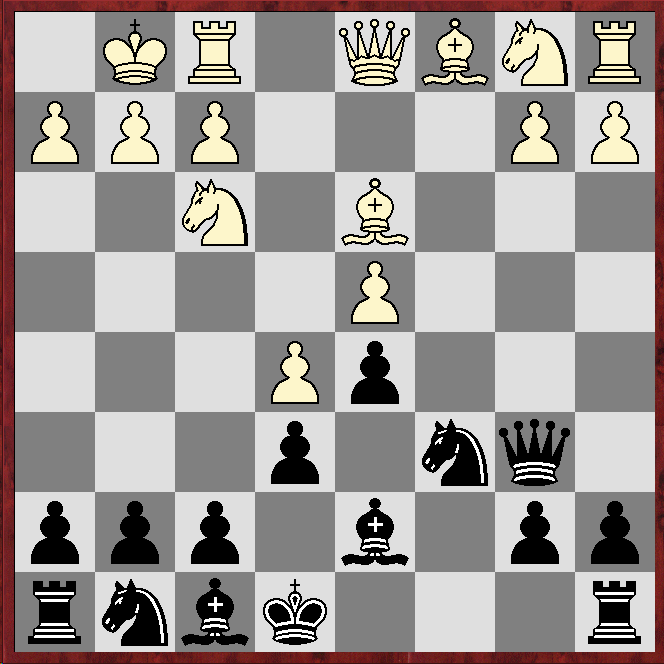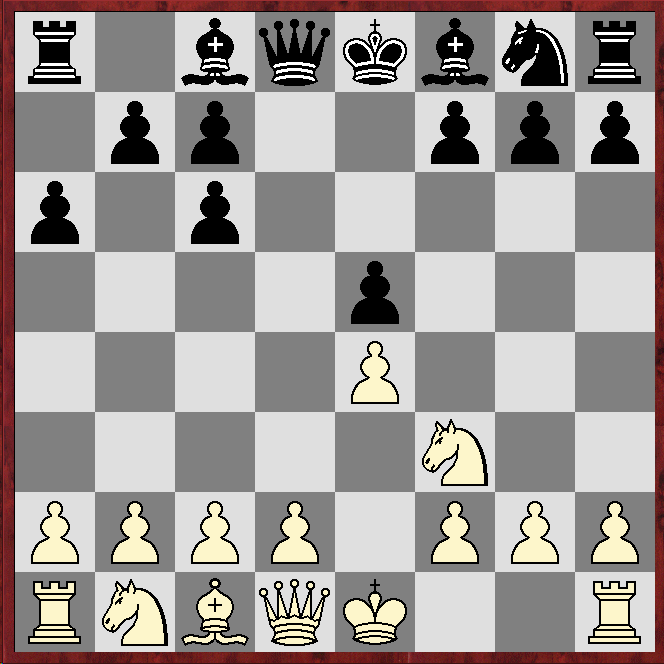HERE is a post I wrote but did not publish during the covid crisis.
In this series I am looking at the statistically best way to play against popular opening lines.
The numbers are drawn from the 2021 edition of ChessBase's Mega database, ignoring, where possible, those results that include very few games and so are statistically insignificant.
A popular answer to the Ruy Lopez, at least at club level, is the Classical Variation: 1.e4 e5 2.Nf3 Nc6 3.Bb5 Bc5.
It could be said Black is meeting the Spanish Opening by playing the black side of the Italian Game.
Of those responses appearing in Mega21 at least 500 times, the most-successful statistically is 4.c3, which scores 62%.
 |
| Position after 4.c3 |
Black has six replies that each appear more than 250 times in Mega21.
A) 4...Nf6 (1,721 games)
After 5.Qe2!? the line splits.
A1 5...0-0 6.0-0 (6.d3 scores equally well, and in practice the two moves often transpose, but castling is more popular and arguably more flexible as the white king is probably destined to end up on the kingside), after which the line splits again.
A1.1 6...Re8 7.d3, when A1.1a 7...h6 8.h3!? scores 86% for White, albeit from a small sample, and A1.1b 7...a6 8.Ba4 b5 9.Bc2 scores 60% for White, albeit from a small sample.
A1.2 6...d6 7.d3, when A1.2a 7...h6 8.Nbd2 scores 90% for White, albeit from a small sample, A1.2b 7...Bb6!? 8.Nbd2 Ne7!? 9.Nc4 scores 58% for White, albeit from a small sample, A1.2c 7...a6 8.Ba4 Ba7!? 9.Be3 scores 83% for White, albeit from a very small sample, and A1.2d 7...Bg4 8.h3 Bh5 9.Nbd2 scores 83% for White, albeit from a very small sample.
A2 5...Qe7 6.d3 0-0 7.Bg5 d6 8.Nbd2 scores 89% for White, albeit from a small sample.
B) 4...f5 (840 games)
After 5.d4 the line splits.
B1 5...fxe4 6.Bxc6 dxc6 7.Nfd2!? Bd6 8.dxe5 e3 (not 8...Bxe5?? 9.Qh5+ etc) 9.exd6 exd2+ 10.Nxd2 scores 71% for White, albeit from a small sample.
B2 5...exd4!? 6.e5!? dxc3 7.Nxc3 scores 80% for White, albeit from a small sample.
C) 4...Nge7 (598 games)
After 5.0-0 the line splits.
C1 5...Bb6!? 6.d4 exd4 7.cxd4 d5 8.exd5 Nxd5 9.Bg5!? scores 77% for White, albeit from a small sample.
C2 5...a6 6.Ba4, after which the line splits again.
C2.1 6...b5 7.Bc2!? (7.Bb3 scores equally well, but Bc2 is less well-known and is preferred by Stockfish13 and Komodo12.1.1), when C2.1a 7...d6 8.d4 exd4 9.cxd4 scores 86% for White, C2.1b 7...0-0 8.d4 exd4 9.cxd4 scores 75% for White, albeit from a small sample, and C2.1c 7...d5 8.d4!? scores 80% for White, albeit from a small sample.
C2.2 6...0-0 7.d4 exd4 8.cxd4, when C2.2a 8...Ba7 9.d5 Nb8 9.d6!? scores 100% for White, albeit from a small sample, and C2.2b 8...Bb6 9.d5 Na7 10.d6!? scores 92% for White, albeit from a small sample.
C3 5...0-0 6.d4 exd4 7.cxd4 Bb6 8.d5, after which the line splits again.
C3.1 8...Nb8 9.d6!? scores 81% for White.
C3.2 8...a6 9.Ba4, when C3.2a 9...Na7 10.d6!? scores 92% for White, albeit from a small sample, and C3.2b 9...Nb8 10.d6!? scores 83% for White, albeit from a small sample.
D) 4...d6!? (481 games)
After 5.d4 exd4 6.cxd4 Bb4+ 7.Kf1!? Bd7 8.Qa4 the line splits.
D1 8...Nge7 9.d5 scores 100% for White, albeit from a small sample.
D2 8...a5 9.a3 scores 100% for White, albeit from a small sample.
D3 8...Qe7 reaches a position in Mega21 in which White scores 100% with both 9.d5 and 9.Bxc6, albeit from very small samples.
E) 4...Qf6!? (335 games)
After 5.d4!? exd4 6.e5 Qg6 7.cxd4 the line splits.
E1 7...Bb4+ 8.Nc3, after which the line splits again.
E1.1 8...d5 9.0-0 Ne7 10.Qb3 Bxc3 10.bxc3 scores 90% for White, albeit from a small ample.
E1.2 8...Nge7 9.0-0 d5 is a transposition to E1.1.
E2 7...Nxd4!? 8.Nxd4 Qb6 9.Be3 Bxd4 reaches a position in Mega21 in which White scores 63% with 10.Qxd4. albeit from a small sample, and 100% with 10.Bxd4, albeit from a very small sample.
F) 4...a6!? (265 games)
After 5.Bxc6!? the line splits.
F1 5...dxc6 6.Nxe5 scores 83% for White, albeit from a small sample.
F2 5...bxc6 6.Nxe5 scores 95% for White, albeit from a small sample.
























